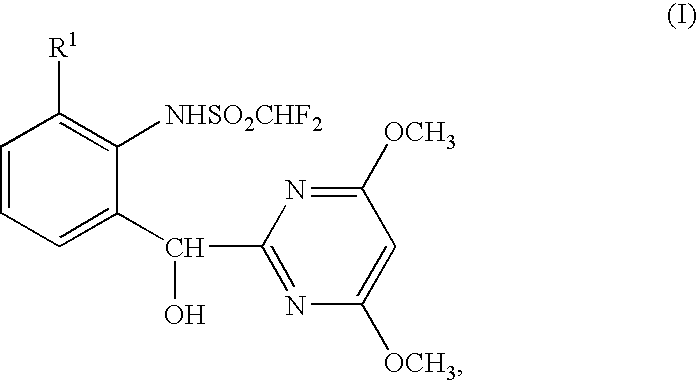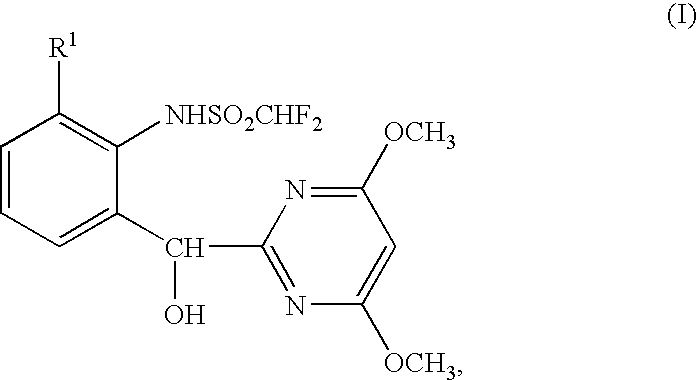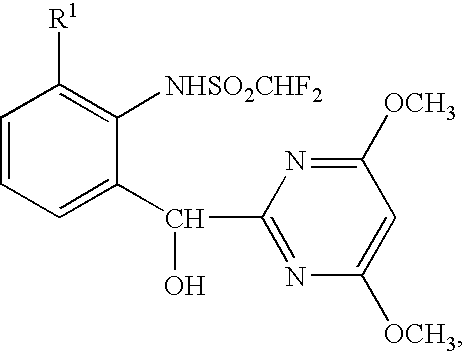Granular pesticide preparation
a pesticide preparation and granular technology, applied in the directions of medical preparations, powder delivery, botany apparatus and processes, etc., can solve the problems of not yet established and significant burden on the environmen
- Summary
- Abstract
- Description
- Claims
- Application Information
AI Technical Summary
Benefits of technology
Problems solved by technology
Method used
Image
Examples
example 1
[0060]A mixture obtained by uniformly mixing 2.55 parts of bensulfuronmethyl (pKa 5.03), 5 parts of distearyldimethylammonium chloride, 2 parts of basic white carbon, 84.45 parts of calcium carbonate, 2 parts of poly(vinyl alcohol) and 4 parts of α-starch was ground in an impact grinder. The thus obtained powder was mixed and kneaded with an appropriate amount of water with a high-speed stirrer and granulated by extrusion through a screen having a mesh opening diameter of 0.3 mm in a dome-type granulator and the granules were allowed to stand at 70° C. followed by drying to obtain pesticide granules having a diameter of 0.2 to 0.4 mm and a length of 0.5 to 1.2 mm and containing 2.55 mass % of bensulfuron-methyl. The thus obtained pesticide granules were put into water and observation was made for disintegration of the granules after 30 minutes to find no disintegrated granules so that they were concluded to be non-disintegrable.
[0061]Then, 85 parts of mefenacet and 15 parts of white...
example 2
[0062]85 Parts of a compound in which R1 in the general formula (I) is a methoxymethyl group (hereinafter referred to as compound A; pKa 5.75) and 15 parts of basic white carbon were uniformly mixed, and finely ground by an air mill to prepare a compound A-containing powder.
[0063]While 76.11 parts of granular diatomaceous earth having a particle size of 42 to 60 mesh (250 to 355 μm) was introduced into a conical screw mixer and stirred, a cationic surfactant solution separately prepared beforehand by mixing and dissolving 10 parts of dioleoyldimethylammonium chloride, 6 parts of propylene glycol and 2 parts of poly(propylene glycol) (molecular weight: 1000) was introduced put thereinto under stirring. Rapidly after the introduction was completed, 5.89 parts of the above compound A-containing powder was put in and uniformly mixed to form granules and the granules were subjected to aging in a shelf drier at 70° C. to obtain pesticide granules containing 5.0 mass % of the compound A an...
example 3
[0065]85 Parts of the compound A (pKa 5.75) and 15 parts of basic white carbon were uniformly mixed, and finely ground by an air mill to prepare a compound A-containing powder.
[0066]While 79.11 parts of Japanese acid clay having a particle size of 24 to 48 mesh (300 to 710 μm) were introduced into a conical screw mixer and a cationic surfactant solution separately prepared beforehand by mixing and dissolving 10 parts of dioleoyldimethylammonium chloride, 4 parts of propylene glycol and 1 part of polypropylene glycol (molecular weight: 1000) was introduced thereinto under stirring. Rapidly after the introduction was completed, 5.89 parts of the above-mentioned compound A-containing powder was put in and uniformly mixed to form granules and the granules were subjected to aging in a shelf drier at 70° C. to obtain pesticide granules containing 5.0 mass % of the compound A and having a particle size of 0.3 to 0.71 mm in diameter. The pesticide granules were put into water and observatio...
PUM
 Login to View More
Login to View More Abstract
Description
Claims
Application Information
 Login to View More
Login to View More - R&D
- Intellectual Property
- Life Sciences
- Materials
- Tech Scout
- Unparalleled Data Quality
- Higher Quality Content
- 60% Fewer Hallucinations
Browse by: Latest US Patents, China's latest patents, Technical Efficacy Thesaurus, Application Domain, Technology Topic, Popular Technical Reports.
© 2025 PatSnap. All rights reserved.Legal|Privacy policy|Modern Slavery Act Transparency Statement|Sitemap|About US| Contact US: help@patsnap.com



